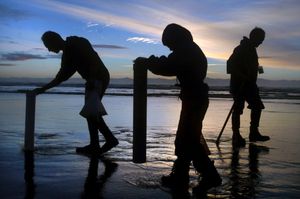Razor clam digging closed for season on Washington Coast
SHELLFISHING -- Digging will remain closed on ocean beaches for the remainder of the razor clam season because of elevated toxin levels, state shellfish managers announced today.
The closure to protect public health ends one of the best razor clam seasons in decades.
The Washington Department of Fish and Wildlife has canceled two openings that were tentatively scheduled to start May 15 and May 22 because of high levels of domoic acid.
The agency canceled three days of a four-day dig earlier this month because of elevated toxin levels.
Domoic acid, a natural toxin produced by certain types of marine algae, can be harmful or even fatal if consumed in sufficient quantities. Razor clams absorb domoic acid into their fat cells and can retain it there long after the ocean water is free of toxins, said Dan Ayres, coastal shellfish manager for WDFW.
“Based on the most recent test results that show increased levels of domoic acid, razor clams will not be safe to eat for the remainder of this month,” Ayres said.
“We’re disappointed to close early, but it has been a remarkable season for razor clam digging in Washington,” Ayres said. “We’ve had healthy and abundant clam populations that have drawn thousands of visitors to our ocean beaches.”
Shellfish managers estimate diggers harvested 5.7 million clams since the season began last October. Diggers had more opportunities to hit the beaches than any season since 1989, Ayres said.
Annual razor clam seasons typically end in mid-to-late May, when the clams begin to spawn and are less desirable for eating, Ayres said. This razor clam season was scheduled to end after the May 22 dig.
WDFW will continue to monitor toxin levels and conduct razor clam stock assessments as usual this summer.
“We hope toxin levels will drop and razor clam digging can begin again this fall,” Ayres said.
Since 1991, when the toxin was first detected on the Pacific coast, outbreaks of domoic acid have prompted the cancellation of three entire razor clam seasons in Washington - the last one in 2002-03. Kalaloch Beach, jointly managed by WDFW and Olympic National Park, also was closed for much of the 2004 season due to high toxin levels. In 2005, WDFW closed Long Beach for two days due to elevated toxin levels.
See more info about razor clam seasons.

